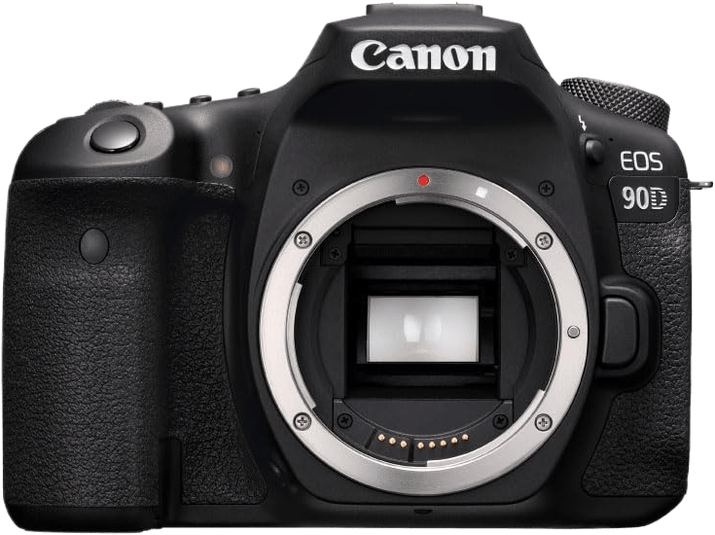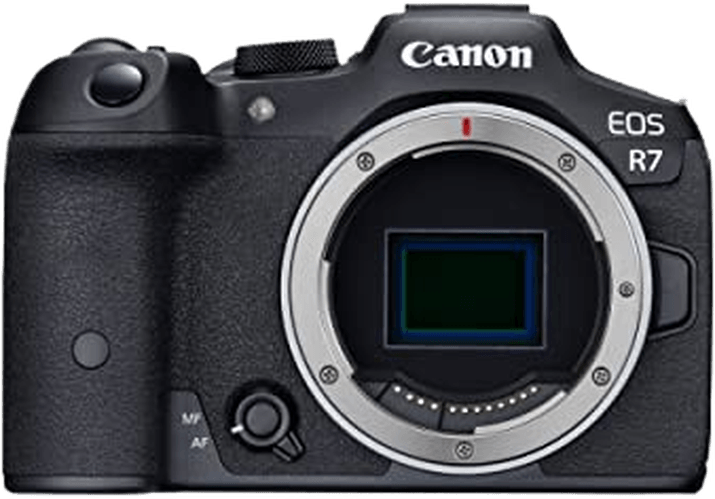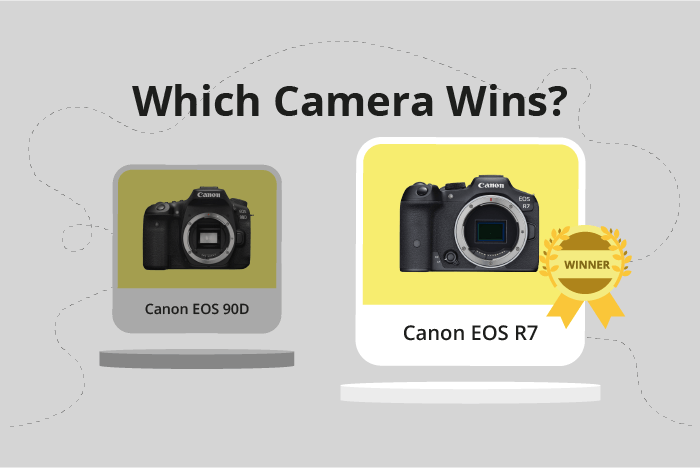Canon EOS 90D vs EOS R7 Comparison
Canon EOS 90D

Canon EOS R7

The Canon EOS R7 outperforms the Canon EOS 90D with a score of 83/100 compared to 67/100. Both cameras, announced in 2019 and 2022 respectively, share common features such as being from the same manufacturer and having a similar price range, with the 90D priced at $1199 and the R7 at $1500.
The EOS R7 excels due to its mirrorless design, resulting in a lighter weight of 612g and smaller dimensions of 132 x 90 x 92mm. This makes the R7 more portable and convenient for on-the-go photography.
On the other hand, the EOS 90D is a DSLR with a slightly larger size of 141 x 105 x 77mm and a heavier weight of 701g. While it falls short in terms of portability, the 90D may offer a more familiar feel for those accustomed to traditional DSLR cameras.
Taking these factors into account, the Canon EOS R7 emerges as the superior choice for its compact and lightweight design, while the EOS 90D caters to those who prefer a traditional DSLR experience.
Canon EOS 90D vs EOS R7 Overview and Optics
The Canon EOS R7 outperforms the Canon EOS 90D in optics with a score of 82/100 compared to the 90D’s 62/100. Both cameras share some common specifications, such as a 33-megapixel CMOS sensor, APS-C sensor size, and the same number of megapixels. However, there are key differences that contribute to the R7’s higher score.
The Canon EOS R7 boasts a superior shooting speed of 15 frames per second, compared to the 90D’s 10 frames per second. This difference allows the R7 to capture fast-moving subjects more effectively. Additionally, the R7 has a significantly higher DXOMARK score for its sensor at 97, compared to the 90D’s 58. This indicates that the R7 can produce images with better color depth, dynamic range, and low-light performance.
Another advantage of the R7 is its Canon RF lens mount, which offers compatibility with a wider range of high-quality lenses. The R7 also features image stabilization, which helps reduce camera shake and produce sharper images, while the 90D lacks this feature.
The Canon EOS 90D, on the other hand, has a Digic 8 processor, which is an older model compared to the R7’s Digic X. This may result in slightly slower processing speeds and reduced image quality. However, the 90D’s Canon EF/EF-S lens mount allows compatibility with a vast selection of lenses, which may be beneficial for photographers with an existing collection of EF/EF-S lenses.
Considering the higher optics score, faster shooting speed, better sensor performance, and image stabilization, the Canon EOS R7 is the clear winner in this comparison. Although the 90D offers compatibility with a wide range of lenses, the R7’s advantages make it a more capable camera for a variety of photography situations.
Canon EOS 90D vs EOS R7 Video Performance
The Canon EOS 90D and the Canon EOS R7 both achieve a video score of 91/100, indicating that they have very similar video capabilities. Both cameras share common specifications such as a maximum video resolution of 4K, maximum video dimensions of 3840 x 2160, a maximum video frame rate of 120fps, and built-in time-lapse functionality.
Despite the identical scores, the Canon EOS 90D has some advantages over the Canon EOS R7. Due to its APS-C sensor, the 90D may offer better video quality in low-light conditions and higher dynamic range. Additionally, the 90D features a fully articulating touch screen, which can be useful for vloggers and content creators who need to monitor their videos while recording.
On the other hand, the Canon EOS R7 has its own strengths. As a mirrorless camera, it offers a more compact and lightweight design, making it easier to carry and handle while shooting videos. Furthermore, the R7 has the advantage of a more advanced autofocus system, which can provide faster and more accurate focus during video recording.
Taking these factors into consideration, both the Canon EOS 90D and the Canon EOS R7 prove to be strong contenders in the realm of video capabilities. The 90D may be better suited for those who prioritize low-light performance and a fully articulating touch screen, while the R7 might be preferred by those who value a compact design and advanced autofocus. Ultimately, the choice between these two cameras will depend on the specific needs and preferences of the videographer.
Canon EOS 90D vs EOS R7 Features and Benefits
The Canon EOS R7 wins the features comparison with a score of 85/100, while the Canon EOS 90D scores 83/100. Both cameras share several specifications, including a 3-inch screen size, touchscreen functionality, flip screen, and the absence of GPS. They also both have WIFI and Bluetooth capabilities.
The EOS R7 outperforms the EOS 90D in screen resolution, boasting 1,620,000 dots compared to the 90D’s 1,040,000 dots. This higher resolution translates into a sharper and clearer display, allowing for superior image review and menu navigation. The two-point difference in the feature score highlights the advantage of the EOS R7’s display.
On the other hand, the EOS 90D does not have significant advantages over the EOS R7 in terms of features. Both cameras have almost identical feature sets, with the only noticeable difference being the screen resolution. The lower score of the EOS 90D is due to its inferior screen resolution, which does not significantly impact the camera’s overall performance.
In comparing the features of the Canon EOS 90D and the Canon EOS R7, the R7 comes out on top due to its superior screen resolution. This advantage enhances the user experience when reviewing images and navigating menus. However, the EOS 90D remains a solid choice, as both cameras share many of the same features. The decision between the two cameras ultimately depends on the individual’s preferences and priorities, with the EOS R7 being the better choice for those who value a higher resolution display.
Canon EOS 90D vs EOS R7 Storage and Battery
The Canon EOS R7 excels in storage and battery, scoring 79 out of 100, compared to the Canon EOS 90D’s score of 48. Both cameras share common specifications, such as accepting SD, SDHC, and SDXC memory cards and being UHS-II compatible.
The EOS R7 outshines the EOS 90D with its two memory card slots, offering more storage capacity and flexibility. Furthermore, the EOS R7 has USB charging capabilities, allowing for convenient and on-the-go charging.
On the other hand, the EOS 90D has a longer battery life, providing 1300 shots per charge compared to the EOS R7’s 660 shots. However, the EOS R7’s battery type, LP-E6NH, is more advanced than the EOS 90D’s LP-E6N.
Ultimately, the Canon EOS R7 offers superior storage and charging options, while the EOS 90D provides a longer battery life. This information can help potential buyers to make an informed decision based on their specific needs and preferences.
Alternatives to the Canon EOS 90D and EOS R7
Are you still undecided about which camera is right for you? Have a look at these popular comparisons that feature the Canon EOS 90D or the Canon EOS R7:

